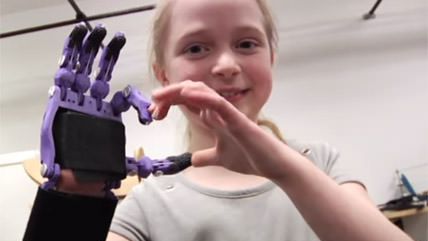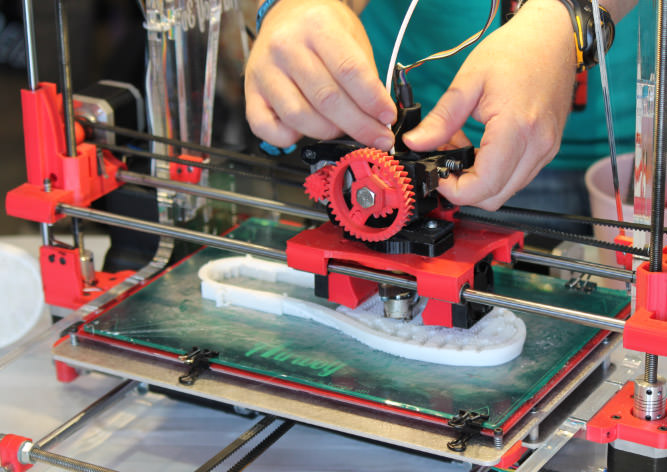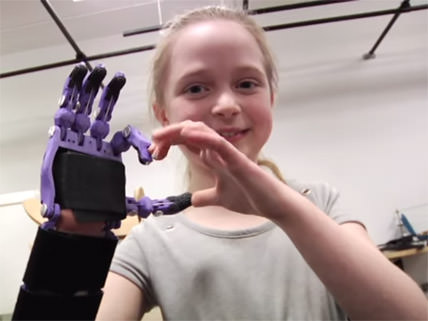Missed Maker Faire? Here Are Two Cool, New 3D-Printed Products


3D-printing often seems overhyped. Well over a dozen organizations peddled 3D-printed wares at Maker Faire in Silicon Valley this weekend, promising that the products are part of an amazing future that will squirt itself out before our very eyes. Most of it was complete junk, glorified paperweights, and thumb-fiddling trinkets. However, there were two standout startups that are actually making people's lives better with printed prosthetic hands and orthotic shoes.
"Six months ago I was going into a shoe store trying on shoes, and I had to try on 10 pairs of shoes to find one that fits because I wear orthotics," Feetz CEO and founder Lucy Beard says. "I went to Starbucks next door and ordered a triple shot mocha with soy milk and realized you can have 87,000 combinations from Starbucks, but I can't go into a shoe store and find a pair that works for me."
So she decided to make a product for people like her. And people unlike her. Feetz is creating completely personalized shoes for 1,000 beta customers. Her shoes can cope with a range of issues like bunions, club foot, or even simply uncommonly large feet.
Beard acknowledges that there are others in the business of 3D printing shoes, but some are hard plastic and require leather insoles. Other companies exclusively print insoles. Others yet print custom shoes, but they're novelties, not orthopedics. Feetz is unique because it offers the entire package.
Throughout the weekend-long event, Beard's printer, an Airwolf, churned out flexible but strong latticework insoles and Croc-esque exteriors. Given the advanced technology and precision customization involved, Feetz's $200 price tag is reasonable. "You can compare it to Nike iD. They sell it for about $200 and you change just the color of the shoe, or orthotics that can range up to $500," says Beard.

At a nearby booth, E-Nable representative Andreas Bastian demonstrated the gripping capabilities of a range of functional prosthetic hands.
"We're focusing on amniotic band syndrome, which is a birth defect in which one or more fingers are stunted in the womb. It's a problem," he says, "in which 3D-printed designs can very cleanly be leveraged to make people's lives better."
An interesting feature of E-Nable, which has existed for less than a year but currently boasts around 860 printers, is that it's completely decentralized, produces its assistive devices on a volunteer basis, and provides them to people free of charge. It's more of a "peer-to-peer network" than a business, says Bastian.
Why do people volunteer their time, money, and resources to this cause?
Bastian explains that many of the makers are motivated to help children, because they "get a tremendous sense of empowerment when they have this device that's produced directly for them."
And producing a hand really isn't expensive. An E-Nable device costs between $25 and $250 to print, compared to prosthetics approved by the Food and Drug Administration, which can cost $50,000. That's not say E-Nable cuts corners on production. They exclusively use materials that have been tested in medical and athletic environments. Some E-Nable device users have said they prefer them to the costlier alternatives.
The E-Nable network's next step forward is to improve products by introducing electrical sensors for more precise muscle control.
Editor's Note: As of February 29, 2024, commenting privileges on reason.com posts are limited to Reason Plus subscribers. Past commenters are grandfathered in for a temporary period. Subscribe here to preserve your ability to comment. Your Reason Plus subscription also gives you an ad-free version of reason.com, along with full access to the digital edition and archives of Reason magazine. We request that comments be civil and on-topic. We do not moderate or assume any responsibility for comments, which are owned by the readers who post them. Comments do not represent the views of reason.com or Reason Foundation. We reserve the right to delete any comment and ban commenters for any reason at any time. Comments may only be edited within 5 minutes of posting. Report abuses.
Please to post comments




I'm sensing a future victim of regulation. Aren't these companies already singled out for extra taxes thanks to Obamacare?
"THOSE PRINTED HANDS ARE MEDICAL DEVICES! 2.3% excise tax, plz."
"Those Printed Hands Are Medical Device" as FDA SWAT breaks down the door.
Feetz don't fail me now!
So she decided to make a product for people like her. And people unlike her.
Clever.
A way with words, this one has.
Alt-text, not so much.
Customization through 3-D printing presents some amazing possibilities. Could be truly revolutionary. So the government should step in and kill it.
The loony-left should be united against this trend what with printers killing jobs for blue-collar unions and promoting that high-tech meritocracy bullshit.
Well, it's true that 3-D printing may threaten union jobs. Uh, oh.
I should have bought that 3d printer at Fry's while it was on sale.
3D printers are suffering right now from cellphone syndrome. The tech is moving so fast that no matter which model you buy, in 2 years it will be an antique.
So don't feel bad, you'll get a much better one next time.
Once again, porn leads the way. Our examples a foot fetish and a hand job.
Consumer level 3D printing may be mostly trinkets and toys today, but there are other technologies making a big difference in how things are made, especially for prototypes or small runs of parts.
Waterjet and laser cutting allow for flat designs to be made from strong materials with low setup charges.
CNC milling allows for higher precision and more 3 dimensional shapes than waterjet or laser, but with higher cost and more complex restrictions.
Finally, high end 3D printing like DMLS can create shapes that are very strong and accurate, but at a high price.
The 3D printing area was more extensive than last year. There were plastic filament vendors and even one vendor selling 3D printing platforms.